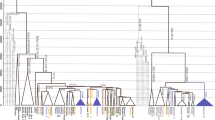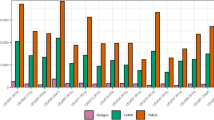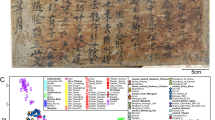Abstract
Y-chromosomes from 76 Chinese men covering 33 ethnical minorities throughout China as well as the Han majority were collected as genetic material for the study of Chinese nonrecombinant Y-chromosome (NRY) phylogeny. Of the accepted worldwide NRY haplogroups, three (haplogroups D, C, O) were significant in this sample, extending previous assessments of Chinese genetic diversity. Based on geographic, linguistic, and ethnohistorical information, the 33 Chinese ethnical minorities in our survey were divided into the following four subgroups: North, Tibet, West, and South. Inferred from the distribution of the newfound immediate ancestor lineage haplogroup O*, which has M214 but not M175, we argue that the southern origin scenario of this most common Chinese Y haplogroup is not very likely. We tentatively propose a West/North-origin hypothesis, suggesting that haplogroup O originated in West/North China and mainly evolved in China and thence spread further throughout eastern Eurasia. The nested cladistic analysis revealed in detail a multilayered, multidirectional, and continuous history of ethnic admixture that has shaped the contemporary Chinese population. Our results give some new clues to the evolution and migration of the Chinese population and its subsequence moving about in this land, which are in accordance with the historical records.
Similar content being viewed by others
Log in or create a free account to read this content
Gain free access to this article, as well as selected content from this journal and more on nature.com
or
References
Cavalli-Sforza LL (1998) The Chinese human genome diversity project. Proc Natl Acad Sci USA 95:11501–11503
Chu JY, Huang W, Kuang SQ, Wang JM, Xu JJ, Chu ZT, Yang ZQ, Lin KQ, Li P, Wu M, Geng ZC, Tan CC, Du RF, Jin L (1998) Genetic relationship of populations in China. Proc Natl Acad Sci USA 95:11763–11768
Davis RS, Ranov VA (1999) Recent work on the paleolithic of Central Asia. Evol Anthropol 8:186–193
Ding YC, Wooding S, Harpending HC, Chi HC, Li HP, Fu YX, Pang JF, Yao YG, Yu JGX, Moyzis R, Zhang YP (2000) Population structure and history in East Asia. Proc Natl Acad Sci USA 97:14003–14006
Fei X (1999) The pattern of diversity in unity of the Chinese nation. Central University for Nationalities, Beijing
Ge J, Wu S, Chao S (1997) The migration history of China (in Chinese). Fujian People, Fuzhou, China
Gladney DC (1996) Muslim Chinese: ethnic nationalism in the people’s republic. Harvard University, Cambridge, MA
Goebel T (1999) Pleistocene human colonization of Siberia and peopling of the Americas: an ecological approach. Evol Anthropol 8:208–227
Gordon D, Abajian C, Green P (1998) Consed: a graphical tool for sequence finishing. Genome Res 8:195–202
Hammer MF, Karafet TM, Rasanayagam A, Wood ET, Altheide TK, Jenkins T, Griffiths RC, Templeton AR, Zegura SL (1998) Out of Africa and back again: nested cladistic analysis of human Y-chromosome variation. Mol Biol Evol 15:427–441
Hammer MF, Karafet TM, Redd AJ, Jarjanazi H, Santachiara- Benerecetti S, Soodyall H, Zegura SL (2001) Hierarchical patterns of global human Y-chromosome diversity. Mol Biol Evol 18:1189–1203
Karafet TM, Zegura SL, Posukh O, Osipova L, Bergen A, Long J, Goldman D, Klitz W, Harihara S, de Knijff P, Wiebe V, Griffiths RC, Templeton AR, Hammer MF (1999) Ancestral Asian source(s) of new world Y-chromosome founder haplotypes. Am J Hum Genet 64:817–831
Karafet TM, Xu L, Du R, Wang W, Feng S, Wells RS, Redd AJ, Zegura SL, Hammer MF (2001) Paternal population history of East Asia: sources, patterns, and microevolutionary processes. Am J Hum Genet 69:615–628
Lell JT, Sukernik RI, Starikovskaya YB, Su B, Jin L, Schurr TG, Underhill PA, Wallace DC (2002) The dual origin and Siberian affinities of native American Y chromosomes. Am J Hum Genet 70:192–206
Li S (1987) History of Chinese ethnic groups (in Chinese). Orient publishing Center, Beijing
Posada D, Crandall KA, Templeton AR (2000) GeoDis: a program for the cladistic nested analysis of the geographical distribution of genetic haplotypes. Mol Ecol 9:487–488
Qamar R, Ayub Q, Mohyuddin A, Helgason A, Mazhar K, Mansoor A, Zerjal T, Tyler-Smith C, Mehdi SQ (2002) Y-chromosomal DNA variation in Pakistan. Am J Hum Genet 70:1107–1124
Rene G (1998) The empire of the steppes [Empire des steppes, in Chinese]. Commercial, Beijing
Su B, Xiao J, Underhill PA, Deka R, Zhang W, Akey J, Huang W, Shen D, Lu D, Luo J, Chu J, Tan J, Shen P, Davis R, Cavalli-Sforza LL, Chakraborty R, Xiong M, Du R, Oefner P, Chen Z, Jin L (1999) Y-Chromosome evidence for a northward migration of modern humans into Eastern Asia during the last ice age. Am J Hum Genet 65:1718–1724
Su B, Xiao C, Deka R, Seielstad MT, Kangwanpong D, Xiao J, Lu D, Underhill PA, Cavalli-Sforza LL, Chakraborty R, Jin L (2000) Y chromosome haplotypes reveal prehistorical migrations to the Himalayas. Hum Genet 107:582–590
Tajima A, Pan I-H, Fucharoen G, Fucharoen S, Matsuo M, Tokunaga K, Juji T, Hayami M, Omoto K, Horai S (2002) Three major lineages of Asian Y chromosomes: implications for the peopling of east and southeast Asia. Hum Genet 110:80–88
Templeton AR, Sing CF (1993) A cladistic analysis of phenotypic associations with haplotypes inferred from restriction endonuclease mapping. IV. Nested analyses with cladogram uncertainty and recombination. Genetics 134:659–669
Templeton AR, Boerwinkle E, Sing CF (1987) A cladistic analysis of phenotypic associations with haplotypes inferred from restriction endonuclease mapping. I. Basic theory and an analysis of alcohol dehydrogenase activity in Drosophila. Genetics 117:343–351
Templeton AR, Routman E, Phillips CA (1995) Separating population structure from population history: a cladistic analysis of the geographical distribution of mitochondrial DNA haplotypes in the tiger salamander, Ambystoma tigrinum. Genetics 140:767–782
Thomson R, Pritchard JK, Shen P, Oefner PJ, Feldman MW (2000) Recent common ancestry of human Y chromosomes: evidence from DNA sequence data. Proc Natl Acad Sci USA 97:7360–7365
Underhill PA, Jin L, Zemans R, Oefner PJ, Cavalli-Sforza LL (1996) A pre-Columbian Y chromosome-specific transition and its implications for human evolutionary history. Proc Natl Acad Sci USA 93:196–200
Underhill PA, Shen P, Lin AA, Jin L, Passarino G, Yang WH, Kauffman E, Bonne-Tamir B, Bertranpetit J, Francalacci P, Ibrahim M, Jenkins T, Kidd JR, Mehdi SQ, Seielstad MT, Wells RS, Piazza A, Davis RW, Feldman MW, Cavalli-Sforza LL, Oefner PJ (2000) Y chromosome sequence variation and the history of human populations. Nat Genet 26:358–361
Underhill PA, Passarino G, Lin AA, Shen P, Mirazon Lahr M, Foley RA, Oefner PJ, Cavalli-Sforza LL (2001) The phylogeography of Y chromosome binary haplotypes and the origins of modern human populations. Ann Hum Genet 65:43–62
Weale ME, Shah T, Jones AL, Greenhalgh J, Wilson JF, Nymadawa P, Zeitlin D, Connell BA, Bradman N, Thomas MG (2003) Rare deep-rooting Y chromosome lineages in humans: lessons for phylogeography. Genetics 165:229–234
Wei DC, Wang RL (2000) Migration and evolution history of Chinese ethnic groups (in Chinese). Hubei People’s publishing house, Wuhan
Wells RS, Yuldasheva N, Ruzibakiev R, Underhill PA, Evseeva I, Blue-Smith J, Jin L et al (2001) The Eurasian heartland: a continental perspective on Y-chromosome diversity. Proc Natl Acad Sci USA 98:10244–10249
Wong HM, Dajani AA (1988) Islamic frontiers in China. Scorpion, London
Yao YG, Kong QP, Bandelt HJ, Kivisild T, Zhang YP (2002) Phylogeographic differentiation of mitochondrial DNA in Han Chinese. Am J Hum Genet 70:635–651
Y Chromosome Consortium (2002) A nomenclature system of the tree of human Y-chromosomal binary haplogroups. Genome Res 12:339–348
Zerjal T, Wells RS, Yuldasheva N, Ruzibakiev R, Tyler-Smith C (2002) A genetic landscape reshaped by recent events: Y-chromosomal insights into central Asia. Am J Hum Genet 71:466–482
Acknowledgements
We are grateful to the DNA donors and the investigators who helped in collecting the samples. We thank Miss Liang Li (undergraduate student, Beijing University, Beijing) for experiment assistant, and Dr Geir Skogerbo (Visiting Scientist, Chinese Academy of Sciences, Beijing) for providing helpful discussion and critical review of our manuscript. This work was supported by Chinese Academy of Sciences Grant KSCX2-2-07, the National High Technology Development Program (973) of China under Grant No. 2002CB713805, and Beijing Science and Technology Commission Grant H010210010113.
Author information
Authors and Affiliations
Corresponding author
Additional information
The first two authors contributed equally to this study.
Rights and permissions
About this article
Cite this article
Deng, W., Shi, B., He, X. et al. Evolution and migration history of the Chinese population inferred from Chinese Y-chromosome evidence. J Hum Genet 49, 339–348 (2004). https://doi.org/10.1007/s10038-004-0154-3
Received:
Accepted:
Published:
Issue date:
DOI: https://doi.org/10.1007/s10038-004-0154-3
Keywords
This article is cited by
-
Genetic analysis of 42 Y-STR loci in Han and Manchu populations from the three northeastern provinces in China
BMC Genomics (2023)
-
Population genetic study of 17 Y-STR Loci of the Sorani Kurds in the Province of Sulaymaniyah, Iraq
BMC Genomics (2022)
-
Genetic Architecture of Southeast-coastal Indian tribal populations: A Y-chromosomal phylogenetic analysis
Egyptian Journal of Forensic Sciences (2019)
-
Prediction of Y haplogroup by polymerase chain reaction-reverse blot hybridization assay
Genes & Genomics (2019)
-
The rs2147578 C > G polymorphism in the Inc-LAMC2–1:1 gene is associated with increased neuroblastoma risk in the Henan children
BMC Cancer (2018)



